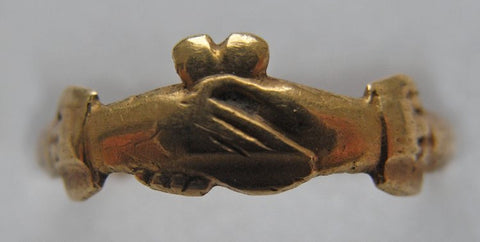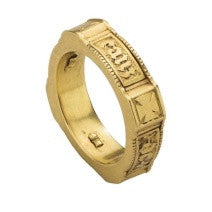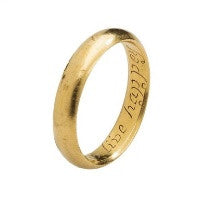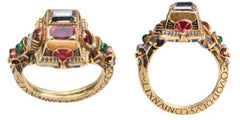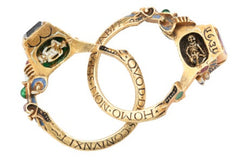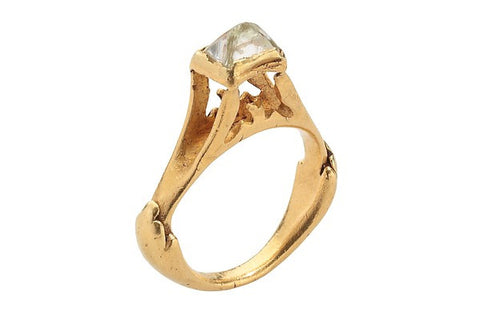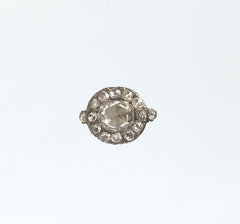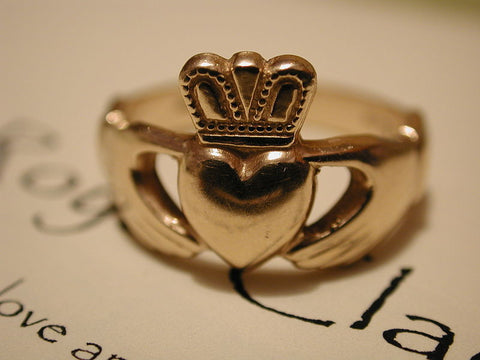ENGAGEMENT RINGS WITH HISTORY
Designs for engagement and wedding rings has varied over the years. From Byzantine rings to the diamond rings of today, we will draw up a summary of the most important ones.
Contents
- Bizantine Rings
- Fede Rings
- Poesie - Posy Rings
- Gimmel Rings
- Jewish Marriage Rings
- Diamond Rings
- Claddagh Rings
Within the ring family, wedding and engagement rings deserve a special section. Engagement Rings and Wedding Rings are a reflection of our marital status (whether past, present or future), both men and women use them.
BYZANTINE RINGS
Gold ring, early Byzantine period, 6th-7th c. We can see the image of the two brides, and in the middle Jesus with outstretched arms. Image: British Museum
Since
ancient times, jewels have been used as
adornments, both to show someone’s
status and as a
charm to avoid bad luck or illness. During the
Islamic and early Byzantine period, they were also intended for special occasions such as
weddings or betrothals. In the
rings that remain from those times, we can find inscriptions with words like "
harmony" or "
amity".
During the
Middle Ages, once
Christianity became the official religion of the Empire, the
figure of Jesus came to be represented in the midst of the bride and groom,
blessing the sacrament.
FEDE RINGS
Gold Fede ring, 16th-17th c.
Source: British Museum of Art
Fede rings first appeared in Rome in the third century. The word "Fede" comes from the Italian phrase "mani en fede" - hands that unite in faith or loyalty.
The main and most characteristic motif is of two hands joined together in the bezel of the ring, representing the union of the hands of the couple in a marriage ceremony ("dextrarum iunctio"). This type of ring was very popular in Europe for more than a thousand years and was used as both engagement and wedding rings in Medieval and Renaissance Europe.
Over time, the design of the Fede
rings became much
more elaborate, and went on to have two or more interlaced loops, a heart in the centre and sometimes featured enamel or another type of adornment with
gemstones.
POESIE - POSY RINGS
Poesie – Posi rings. 17th c.
Source: Met Museum of Art
In the
Elizabethan era, it became customary to give
simple gold hoops as a
sign of love. These rings were
engraved with a brief "
posy - poesi" poems. At first, these short verses were engraved on the outside of the ring, and later went on to be featured on the band’s interior.
The design of the posy ring, as well as where the inscription was placed, also varied over the years, initially they were more refined and excessively ornate and then went on to be a simple gold ring featuring more romantic inscriptions, hidden in the interior to be kept private "Two bodies, one heart", etc.).
GIMMEL RINGS
Gimmel rings with memento mori, 17th c.
Source: MET Museum of Art
The
name of the
Gimmel ring comes from the Latin word "
gemellus" meaning
twin, since the ring was comprised of
two rings that were
interlaced. Traditionally, the betrothed couple each received one of these rings, and at the
wedding ceremony both rings were
joined as a symbol of the confirmation of consent.
Over time, Gimmel rings became more and more elaborate, sometimes featuring more than two hoops, and they were often referred to as puzzle rings, decorated with enamel, gemstones, inscriptions and secret departments.
During the Renaissance appeared the jewels of "memento mori" appeared, which recalled death. They were a reminder that death was always present and unpredictable. These pieces combined beauty with decadence, life and death, in order to incite devotion.
JEWISH MARRIAGE RINGS
Back to Top

Jewish wedding ring, gold with filigree and blue, green and white enamel 16th to 19th c. Source: British Museum
In the past, wedding rings were also an important part of Jewish customs, as far as marriage is concerned.
At the end of the Middle Ages and during the Renaissance, large and elaborate matrimonial rings with filigree, enamel and inscriptions were used in the marriage ceremony.
These bulky rings were exchanged during Italian Jewish wedding ceremonies. The bridegroom put it on the bride's finger and once the ceremony was over, it became a familiar memory, or it was given to the temple community.
The rings represent a gabled roof, probably an allusion to the Temple of Jerusalem, and would often have a small secret chamber, where the words Mazal Tov (good luck) were inscribed in Hebrew.
DIAMOND RINGS
Back to Top
Roman ring, made in gold and a rough diamond 3th c. Source: Met Museum of Art
Diamonds have been highly prized by man for millennia. The word diamond comes from the Greek word "adamaos", which means "invincible, hard, that which doesn't break". Jewels have always been used as amulets, and gems were endowed with certain "powers", so it is not strange to find wonderful old pieces adorned with diamonds. In the case of diamonds, they were very popular in jewellery in the antiquity, although at the beginning they were used without carving.
But it was not until the 15th c. when they began to be used in engagement rings. One of the earliest documented uses of an engagement ring using diamonds dates back to 1477, in the ring for the engagement of Archduke Maximilian of Austria to Mary of Burgundy.
Gold and diamonds engagements ring. 18th c.
Source: Met Museum of Art
This implied a great demand for diamonds in engagement rings on the part of the highest social classes of the time, and became widely used in the 17th and 18th centuries as engagement and wedding rings.
Today, the popularity of diamond engagement rings is in part due to the
De Beers firm, and the magnificent
marketing campaign it led in the mid-1940s. "A diamond is forever" was the slogan that changed the diamond and jewellery industry.
CLADDAGH RINGS
Back to Top
Claddagh ring Source: Wikipedia.
The ring of Claddagh (Ireland), is a variant of the Fede ring, dating back to the seventeenth century and is still being used up to today. This ring consists of two hands holding a crowned heart, and is given as either an engagement ring or as a symbol of courtship.

